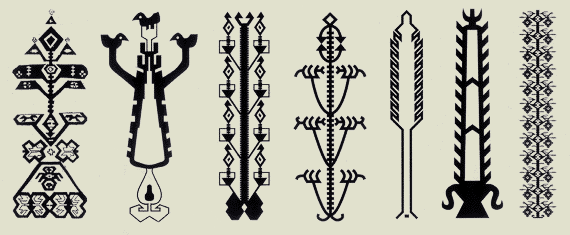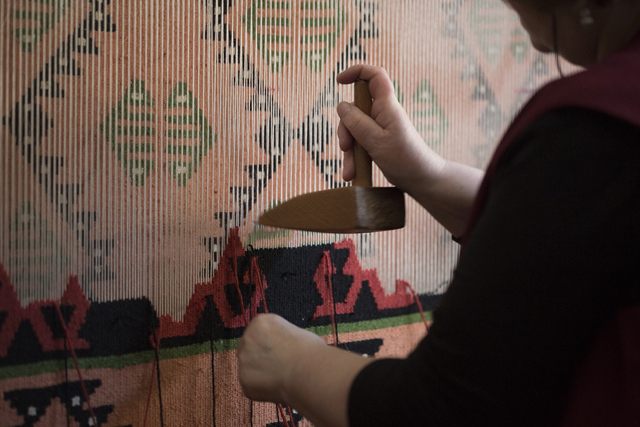*FAST DELIVERY WITH UPS WORLDWIDE
Vintage Kilim Pillow Cover.
Size: 12x24 inches (30x60cm)
Condition: Excellent vintage condition.
Each of the Kilim Pillow Covers is cut from a vintage Turkish kilim, so no two pillows are ever exactly alike.
Front of the case is made from a hand-woven kilim, 100% wool. Back is made out of 100% cotton fabric and there is zip to put fillings or inserts.
(Please note that inserts are not included)
Actual kilim was a dowry piece, made by a girl bride-to-be. It was made in a small Anatolian town in Turkey in 1960-70s. It has been kept in a dowry chest mostly. (A typical Turkish tradition)
Handwoven, handcrafted, vintage kilim pillow covers not only bring some history and style into your home, they also all have meanings with their motifs and they can tell a lot about where they came from or about the person who made them. Each small pattern has its special meaning, soul and history.
(please see below for the meanings of the motifs on kilims)
If you want a piece of unique, craftsmanship of beauty in your home this pillow case is what you are looking for.
They are great as bedroom or couch pillows, but can also be used for lots of different purposes, like table toppers, placemats, and even wall art.
Care:
•Just brush to remove loose dirt and dust.
•For blot spills, use a dry cloth at once.
•Spot cleaning to remove stains
•Non colourfast treatment recommended.
*All our shipments will be from our shop in Grand Bazaar, Istanbul via UPS tracked delivery. We also have an office in the UK. Secure payment with all credit cards via PayPal. You don't need to have a PayPal account. We are pretty sure that you will be very happy with your purchase. However, if you have any questions with your purchase please do contact us so we can solve right away.
Meanings of the motifs on kilims:
 Fetter: (used as a Horse or camel cuff) When woven, used to symbolise family unity and staying together.
Fetter: (used as a Horse or camel cuff) When woven, used to symbolise family unity and staying together.
 Wolf print/mouth: Protection from wolves/wild animals. Understandable given the damage that a wolf could do to the nomadic tribes flock and hence entire lifestyle.
Wolf print/mouth: Protection from wolves/wild animals. Understandable given the damage that a wolf could do to the nomadic tribes flock and hence entire lifestyle.
 Earring: Desire to marry. Earrings and other gold items were and still are a common and desirable wedding gift.
Earring: Desire to marry. Earrings and other gold items were and still are a common and desirable wedding gift.
 Hair band: Desire to marry. Hair bands form an important ornamental decoration during the wedding ceremony.
Hair band: Desire to marry. Hair bands form an important ornamental decoration during the wedding ceremony.
 Chest: Desire to marry. A young brides dowry and belongings often packed into the chests and transported for her new marriage.
Chest: Desire to marry. A young brides dowry and belongings often packed into the chests and transported for her new marriage.
 Ram’s horns: Fertility, heroism, power and masculinity.
Ram’s horns: Fertility, heroism, power and masculinity.

 Elinbelinde (hands on hips): Female strength, fertility, motherhood. This is one of the oldest Anatolian motifs and a source of great interest to those that subscribe to the ‘Mother Goddess’ theory regarding the origin of Anatolian kilims.
Elinbelinde (hands on hips): Female strength, fertility, motherhood. This is one of the oldest Anatolian motifs and a source of great interest to those that subscribe to the ‘Mother Goddess’ theory regarding the origin of Anatolian kilims.
 Scorpion: Protection.
Scorpion: Protection.
 Burdock (thorn): Thought to provide protection and also for ‘abundance’.
Burdock (thorn): Thought to provide protection and also for ‘abundance’.
 Star: Generally thought to mean happiness. Although some believe it to represent the womb, hence it could also be a fertility motif.
Star: Generally thought to mean happiness. Although some believe it to represent the womb, hence it could also be a fertility motif.
 Running water: Since all life is dependent upon water, it is a widely used motif thought to represent life. It is interesting to note that what we call ‘borders’, weavers call them ‘springs’ or ‘streams’.
Running water: Since all life is dependent upon water, it is a widely used motif thought to represent life. It is interesting to note that what we call ‘borders’, weavers call them ‘springs’ or ‘streams’.
 Hand, finger, comb: Protection of marriage and birth from the evil eye (other people’s jealousies and ill wishes). During the Islamic period, the use of a 5 fingers or hand motif was used to represent ‘hand of Fatma’ (Mother Fatima).
Hand, finger, comb: Protection of marriage and birth from the evil eye (other people’s jealousies and ill wishes). During the Islamic period, the use of a 5 fingers or hand motif was used to represent ‘hand of Fatma’ (Mother Fatima).
 Muska: (Amulet) A triangular motif, supposed to have magical properties, derived from the shape of a pouch used to carry Koranic inscriptions or religious or shamanistic relics.
Muska: (Amulet) A triangular motif, supposed to have magical properties, derived from the shape of a pouch used to carry Koranic inscriptions or religious or shamanistic relics.
 Cross: Protection yet again. It is thought that the cross, in its various forms divides the evil into smaller parts. The motif has been in long use prior to Christianity.
Cross: Protection yet again. It is thought that the cross, in its various forms divides the evil into smaller parts. The motif has been in long use prior to Christianity.
 Tree of Life: The tree is the common theme for all religions believing in one God. In all 3 religious scriptures (Torah, Bible and Quran) the fruit which is believed to bring immortality, is forbidden to all mortals when the serpent (Satan) convinced Adam and Eve to eat it. Mankind, unable to eat the fruit of immortality, put all their hopes on the life after death symbolized by a tree of life.
Tree of Life: The tree is the common theme for all religions believing in one God. In all 3 religious scriptures (Torah, Bible and Quran) the fruit which is believed to bring immortality, is forbidden to all mortals when the serpent (Satan) convinced Adam and Eve to eat it. Mankind, unable to eat the fruit of immortality, put all their hopes on the life after death symbolized by a tree of life.
 Bird: No other motif has so many varied meanings as the bird motif to the Anatolian weavers. Bad luck, good luck, the symbol of happiness, joy and love. But also the soul of the dead. It is longing, and expectation of news. It can also stand for power and strength.
Bird: No other motif has so many varied meanings as the bird motif to the Anatolian weavers. Bad luck, good luck, the symbol of happiness, joy and love. But also the soul of the dead. It is longing, and expectation of news. It can also stand for power and strength.
